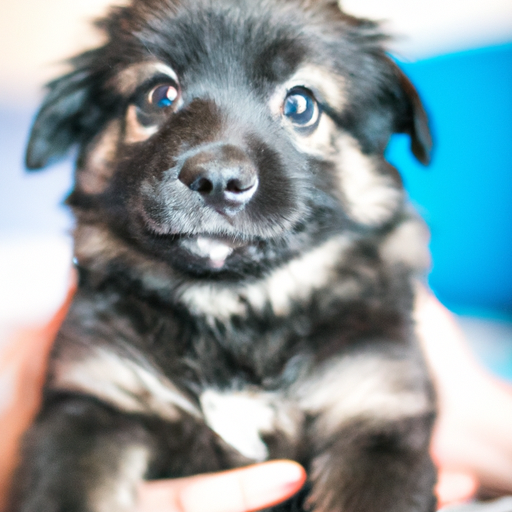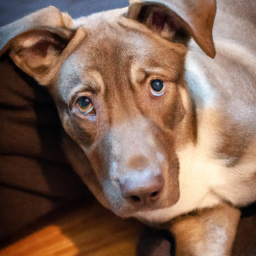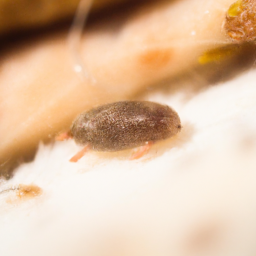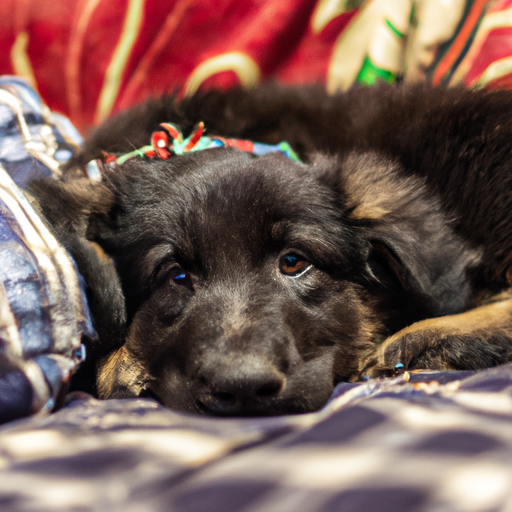Introduction to Dog Fleas
Dog fleas are small, wingless insects that thrive on the blood of their hosts, causing discomfort and potential health issues for pets. These parasitic pests are a common concern for dog owners worldwide, given their ability to cause a range of problems for both pets and their human companions. Understanding dog fleas—their biology, impact, and management—is crucial for maintaining a healthy environment for dogs.
Definition and Overview
Dog fleas, scientifically known as Ctenocephalides canis, are external parasites that specifically target dogs. However, they are not exclusive to canines and may also infest cats and other animals, including humans. Characterized by their flattened bodies and powerful legs, fleas are adept jumpers, allowing them to move quickly between hosts. Their small size and rapid reproduction make them particularly challenging to control.
Why Fleas are a Concern for Dog Owners
Fleas are more than just an itchy nuisance; they pose significant health risks to dogs. These pests can lead to severe skin irritations, allergic reactions, and more serious health issues if left unchecked. For dog owners, understanding the implications of a flea infestation is essential to protecting both their pets and their households from the discomfort and diseases associated with these pests.
Lifecycle of a Flea
Understanding the lifecycle of a flea is integral to controlling and preventing infestations. Fleas undergo a complete metamorphosis, which includes several stages that each require targeted interventions to effectively manage.
Stages of Flea Development
The flea lifecycle consists of four main stages: egg, larva, pupa, and adult. Female fleas lay tiny white eggs on the host animal, which then fall into the environment, such as carpets, bedding, or outdoor areas frequented by the dog. These eggs hatch into larvae within a few days, which feed on organic matter, including flea feces, to grow and develop. Following the larval stage, fleas enter the pupal stage, where they are cocooned and can remain dormant for weeks or even months until environmental conditions trigger their emergence as adults. Once they emerge, adult fleas seek a host to begin the cycle anew.
How Fleas Reproduce and Spread
Fleas reproduce rapidly, with a single female capable of laying up to 50 eggs per day. This prolific breeding means that a small number of fleas can quickly escalate into a large infestation. Fleas spread mainly through contact with infested animals or environments. They can easily transfer from one host to another, making it essential for dog owners to be vigilant in environments where their pets might interact with other animals or fleas.
Identifying Fleas on Dogs
Early detection of fleas can prevent a minor problem from becoming a major infestation. Dog owners should be familiar with the signs of flea presence to take immediate action.
Physical Signs of Flea Infestation
Physical signs of fleas on dogs include the presence of flea dirt (flea feces) in the dog’s fur, which looks like tiny black specks. Owners may also notice adult fleas moving through the fur, especially on the belly, tail, and neck areas. In severe cases, dogs may develop bald patches from excessive scratching or biting.
Behavioral Changes in Dogs with Fleas
Dogs infested with fleas often exhibit behavioral changes due to discomfort. Common behaviors include excessive scratching, biting, or licking at the skin, restlessness, and irritability. Some dogs may develop flea allergy dermatitis, a hypersensitive reaction to flea bites that exacerbates these symptoms.
Health Risks Associated with Fleas
The presence of fleas on dogs poses several health risks that go beyond mere itching and discomfort.
Common Diseases Transmitted by Fleas
Fleas are vectors for various diseases, including tapeworms and Bartonella (cat scratch fever). Dogs can become infected with tapeworms by ingesting fleas during grooming. Bartonella, although more commonly associated with cats, can also affect dogs, leading to symptoms such as fever and swollen lymph nodes.
Allergic Reactions and Skin Irritations
Flea bites can cause allergic reactions in some dogs, leading to flea allergy dermatitis. This condition results in severe itching, inflammation, and skin lesions, requiring veterinary intervention. Additionally, continuous flea bites can lead to secondary skin infections, further complicating the dog’s health.
Preventing Flea Infestations
Preventive measures are key in managing and controlling dog fleas. By implementing routine practices, dog owners can reduce the likelihood of infestations.
Regular Grooming and Hygiene Practices
Regular grooming, such as brushing and bathing, helps remove fleas and their eggs from the dog’s coat. Using flea combs can aid in physically removing fleas and flea dirt. Additionally, maintaining good hygiene by washing the dog’s bedding and toys regularly can help minimize the presence of fleas in the home.
Environmental Controls and Yard Maintenance
Since flea eggs and larvae often reside in the environment, maintaining a clean home and yard is crucial. Regular vacuuming of carpets and furniture, as well as washing pet bedding, can reduce flea populations. In outdoor spaces, keeping the yard tidy by mowing the lawn and removing debris can decrease the likelihood of fleas breeding in the area. Utilizing flea control products, such as sprays and powders, can also be effective in breaking the flea lifecycle.
By understanding and implementing these strategies, dog owners can protect their pets from the discomfort and health risks posed by dog fleas, ensuring a happy and healthy life for their furry companions.
Flea Treatment Options
Dog fleas are a common concern for pet owners, and addressing them promptly is crucial for the comfort and health of your furry friend. There are several flea treatment options available, ranging from readily accessible over-the-counter products to more specialized prescription medications.
Over-the-Counter Flea Treatments
Over-the-counter flea treatments are popular among pet owners for their convenience and affordability. These products, which include topical treatments, flea collars, and shampoos, are designed to kill fleas on contact and prevent future infestations. Topical treatments, such as spot-on applications, are applied directly to the dog’s skin and can provide protection for up to a month. Flea collars are another effective option, as they release active ingredients over time to repel and kill fleas.
While these treatments can be effective, it’s essential to choose a product specifically formulated for dogs, as some flea treatments for other animals can be harmful to dogs. Additionally, pet owners should always follow the manufacturer’s instructions to ensure the safety and efficacy of the treatment.
Prescription Medications and Treatments
For severe infestations or dogs with specific health needs, prescription medications might be necessary. Veterinarians can prescribe oral medications that work systemically to kill fleas and prevent them from reproducing. These medications often provide fast relief and can be a lifesaver in cases of heavy infestations.
Prescription topical treatments are also available and may offer longer-lasting protection compared to over-the-counter options. Consulting with a veterinarian is crucial to determine the most appropriate treatment for your dog’s specific needs and to ensure there are no adverse interactions with other medications your dog may be taking.
Natural Remedies for Flea Control
Many pet owners seek natural remedies for controlling dog fleas, preferring to avoid chemical treatments when possible. While these alternatives can be effective, it’s essential to weigh their benefits and limitations.
Herbal and Natural Solutions
Herbal and natural solutions for flea control include the use of essential oils, such as lavender, peppermint, and eucalyptus, which are known for their flea-repelling properties. These oils can be diluted and applied to a dog’s coat or used in a flea-repellent spray. Diatomaceous earth, a natural powder, can be sprinkled on carpets and pet bedding to kill fleas by dehydrating them.
Additionally, regular grooming and bathing with natural shampoos can help reduce flea populations and provide relief for dogs with sensitive skin. However, it’s important to ensure that any natural product used is safe for dogs, as some essential oils can be toxic to pets.
Pros and Cons of Natural Remedies
Natural remedies offer several advantages, such as being free from harsh chemicals and often having fewer side effects. They can be a great option for puppies, senior dogs, or dogs with allergies to conventional treatments. However, natural remedies may not always provide the same level of efficacy as conventional treatments, especially in cases of severe infestations.
Pet owners considering natural remedies should be prepared to use them consistently and in conjunction with other flea control measures to achieve the best results.
Flea Control for Puppies and Senior Dogs
Controlling dog fleas in puppies and senior dogs requires special considerations due to their unique health needs and vulnerabilities.
Special Considerations for Puppies
Puppies are particularly susceptible to flea infestations, and their immune systems are not fully developed, making them more vulnerable to the effects of fleas. It’s essential to use flea treatments that are specifically formulated for puppies, as their skin is more sensitive, and they may not tolerate the active ingredients found in adult flea treatments.
Regular grooming and environmental control are crucial for keeping fleas at bay in puppies. Pet owners should also consult with a veterinarian to determine the most appropriate and safe flea treatment for their young dogs.
Adjustments for Senior Dog Care
Senior dogs may have underlying health issues that can be exacerbated by fleas or the treatments used to combat them. Flea control for senior dogs should be approached with care, considering their overall health condition. Some senior dogs may benefit from milder treatments or natural remedies to minimize stress on their bodies.
Regular veterinary check-ups can help monitor the health of senior dogs and ensure that flea treatments do not interfere with any existing medical conditions or medications.
Flea Infestation in the Home
Dog fleas can quickly spread throughout the home, making it essential to address both the pet and the household environment to effectively manage an infestation.
Signs of Fleas in Household Environments
Flea infestations in the home can manifest in several ways. Pet owners may notice their dogs scratching excessively or observe small, dark specks (flea dirt) on their dog’s skin or bedding. Fleas can also be spotted jumping on carpets, furniture, or even on human skin.
In severe infestations, fleas may bite humans, resulting in itchy red bumps. It’s crucial to address these signs promptly to prevent the infestation from worsening.
Steps to De-flea Your Home
To de-flea your home, it’s important to clean and vacuum all areas where your dog spends time, including carpets, rugs, and upholstery. Washing pet bedding, toys, and any removable fabric items in hot water can help eliminate flea eggs and larvae.
Using flea sprays or powders designed for home use can also aid in controlling the flea population within the household. For severe infestations, professional pest control services may be necessary to eliminate fleas effectively.
Understanding Flea Resistance
As with many pests, dog fleas can develop resistance to treatments, making it more challenging to control infestations and maintain the health of your pet.
How Fleas Develop Resistance to Treatments
Fleas can develop resistance to treatments through genetic mutations and the selective pressure of repeated exposure to specific active ingredients. Over time, this can result in certain flea populations becoming unaffected by treatments that were once effective.
Pet owners should be aware that using the same treatment repeatedly can contribute to resistance, making it important to rotate products or combine different methods of flea control.
Strategies to Combat Resistance
To combat flea resistance, pet owners can employ several strategies. Rotating between different classes of flea control products can reduce the likelihood of resistance developing. Additionally, maintaining good hygiene practices and using a combination of treatments, such as topical applications, oral medications, and environmental control, can enhance effectiveness.
Regular consultations with a veterinarian can provide valuable guidance on managing flea resistance and ensuring that your dog receives the most effective treatment available. By staying informed and proactive, pet owners can help keep their dogs free from fleas and maintain a healthy, comfortable living environment.
Seasonal Flea Activity
Understanding the seasonal activity of dog fleas is crucial for effective prevention and control. Fleas are resilient pests that thrive in specific climates and seasons, making it essential for pet owners to be proactive in managing their presence.
Flea Activity in Different Climates
Dog fleas are influenced by the climate they inhabit. In temperate regions, flea activity tends to peak during the warmer months of spring and summer. The increased temperatures and humidity levels create an ideal breeding ground for fleas, allowing them to reproduce rapidly. In contrast, colder climates might experience reduced flea activity during the winter, but this does not mean fleas disappear entirely. Indoor heating can create a suitable environment for fleas to survive year-round, especially in homes with pets.
In tropical and subtropical climates, flea activity remains high throughout the year. The consistent warmth and humidity ensure that fleas are a persistent problem, requiring continual vigilance from pet owners. Understanding the climate-specific behavior of dog fleas is key to tailoring an effective control strategy.
Preparing for Flea Season
To prepare for flea season, pet owners should start by ensuring their pets are on a veterinarian-approved flea prevention regimen. This can include topical treatments, oral medications, or flea collars designed to repel and kill fleas. Regular grooming and bathing can help keep dog fleas at bay by removing any fleas or larvae present on the pet’s fur.
In addition to treating the pet, it’s vital to address the home environment. Regular vacuuming of carpets, upholstery, and pet bedding can significantly reduce the likelihood of flea infestations. Washing pet bedding in hot water and using flea sprays or powders on rugs and furniture can help eliminate flea eggs and larvae before they mature.
Flea Allergic Dermatitis
Flea allergic dermatitis (FAD) is a common and distressing condition caused by an allergic reaction to flea saliva. It is one of the most frequent skin disorders seen in dogs, and managing it requires a comprehensive approach.
Symptoms and Diagnosis
Symptoms of flea allergic dermatitis in dogs include intense itching, red and inflamed skin, hair loss, and the presence of scabs or hot spots. These symptoms are typically concentrated around the base of the tail, abdomen, and inner thighs. In severe cases, dogs may develop secondary bacterial infections due to excessive scratching and biting.
Diagnosing FAD involves a combination of clinical signs and a history of flea exposure. A veterinarian may also perform a flea comb test to detect fleas or flea dirt on the dog’s coat. In some cases, a blood test or intradermal skin testing may be recommended to confirm a flea allergy.
Treatment and Management
The primary goal in treating flea allergic dermatitis is to eliminate the source of the allergy—dog fleas. This involves implementing rigorous flea control measures for both the pet and its environment. In addition to flea prevention, veterinarians may prescribe anti-inflammatory medications, such as corticosteroids or antihistamines, to alleviate itching and inflammation.
For dogs with severe FAD, a hypoallergenic diet or supplements rich in omega-3 fatty acids may be recommended to improve skin health. Regular follow-up with the veterinarian is essential to monitor the dog’s progress and adjust treatment plans as needed.
Veterinary Advice and Consultation
When dealing with dog fleas and related issues, seeking professional veterinary advice is invaluable. Veterinarians can provide tailored recommendations based on the specific needs of the pet and the extent of the flea problem.
When to Seek Professional Help
Pet owners should consider consulting a veterinarian if they notice persistent scratching, skin lesions, or other signs of discomfort in their dog. Additionally, if over-the-counter flea treatments fail to control the infestation, professional guidance is necessary. Veterinarians can recommend more potent prescription-strength flea control products and assess the pet for any underlying health issues that may be exacerbating the flea problem.
Questions to Ask Your Veterinarian
When visiting the veterinarian, pet owners should be prepared to ask questions that can help them better manage dog fleas. Some important questions include:
– What is the most effective flea prevention method for my dog?
– Are there any side effects to the recommended flea treatments?
– How can I ensure my home remains flea-free?
– What steps should I take if my dog continues to show signs of flea allergic dermatitis?
Fleas and Other Pets
Dog fleas do not discriminate and can affect other pets in the household, leading to a broader flea problem that requires comprehensive management.
Impact on Cats and Other Household Animals
While dog fleas primarily target dogs, they can also infest cats and other animals living in the same environment. Cats can suffer from similar allergic reactions and skin irritations caused by flea bites. In multi-pet households, it is crucial to treat all animals for fleas to prevent cross-species infestations and ensure the health and comfort of every pet.
Cross-Species Flea Control
Effective flea control involves treating all pets in the household with appropriate flea preventatives, each tailored to the specific animal. This might include using different products for cats and dogs, as some dog flea treatments can be toxic to cats. Maintaining a clean living environment is equally important. Regular cleaning and vacuuming can help reduce flea populations and prevent the spread of fleas between pets.
Future Trends in Flea Prevention
Advancements in flea prevention and control are continually emerging, offering new hope for pet owners in the battle against dog fleas.
Advances in Flea Treatment Technologies
Recent developments in flea treatment technologies include longer-lasting oral medications that provide protection for up to three months. These medications not only kill existing fleas but also prevent new infestations by disrupting the flea life cycle. Additionally, innovative flea collars that offer extended protection and are water-resistant have become increasingly popular among pet owners seeking convenient solutions.
Emerging Research in Flea Control
Ongoing research in flea control is exploring natural and eco-friendly alternatives to traditional chemical treatments. Essential oils and plant-based compounds are being studied for their potential flea-repelling properties. Additionally, researchers are investigating the use of biological control methods, such as nematodes and fungi, to target flea populations in the environment.
As the understanding of flea biology and behavior evolves, pet owners can expect more effective and sustainable options for managing dog fleas in the future. By staying informed about these trends and working closely with veterinarians, pet owners can ensure their dogs remain healthy and comfortable, free from the nuisance of fleas.
Quick Takeaways:
Dog fleas, scientifically known as *Ctenocephalides canis*, are tiny parasites that can cause significant discomfort for your canine companions. Recognizing the symptoms of fleas on dogs is crucial. Look for excessive scratching, hair loss, red bumps, and flea dirt (dark specks) on their skin. Early detection can help prevent a full-blown infestation.
Fleas can transmit diseases and cause allergies. To check your dog for fleas, use a fine-toothed flea comb and inspect areas like the neck, tail, and belly, where fleas often hide. If you find fleas, it’s essential to act quickly. Consider natural flea repellent for dogs, such as essential oils like lavender or lemon, as a chemical-free option. However, be cautious, as some oils can be harmful to pets.
For puppies, the best flea treatment should be gentle yet effective. Always consult your veterinarian for recommendations suitable for your puppy’s age and weight. Flea prevention tips for dogs include regular grooming, maintaining a clean environment, and considering flea control products that target all flea lifecycle stages.
Home remedies for dog fleas, like diatomaceous earth or apple cider vinegar, can be effective but should be used with care. For severe infestations, professional pest control might be necessary. Remember, fleas can develop resistance to treatments, so rotating products periodically may help maintain efficacy.
FAQs:
1.
What are the symptoms of fleas on dogs?
The presence of fleas on dogs can be identified through various symptoms. Common signs include excessive scratching, biting at the skin, hair loss, and visible red bumps or scabs. Dogs may also exhibit restlessness and discomfort. Flea dirt, which looks like small black pepper flakes, is another telltale sign. It’s crucial to address these symptoms promptly to prevent further health issues and flea infestations.
2.
How can I naturally get rid of dog fleas?
To get rid of dog fleas naturally, consider using diatomaceous earth, a fine powder that dehydrates and kills fleas. Sprinkle it lightly on your dog’s coat and in areas where your dog frequently rests. Additionally, essential oils like lavender or cedarwood can serve as natural flea repellents. Use them sparingly and always dilute with a carrier oil to ensure they are safe for your dog’s skin. Regularly washing your dog’s bedding in hot water and vacuuming can also help control flea populations.
3.
What is the best flea treatment for puppies?
The best flea treatment for puppies should be both safe and effective, taking into account their age and weight. Topical treatments specifically designed for puppies, such as those containing fipronil or imidacloprid, are often recommended. Oral medications might also be available for older puppies. Always consult with a veterinarian to ensure the chosen product is appropriate and safe for your puppy.
4.
How can I prevent a flea infestation in my home?
Preventing a flea infestation in your home involves a multi-faceted approach. Start by maintaining cleanliness; vacuum regularly, focusing on carpets, upholstery, and pet bedding. Use flea control products on both your pets and in your home environment to break the flea lifecycle stages. Washing pet bedding in hot water and using flea traps can also be effective. Consider treating your yard with pet-safe products to prevent fleas from entering your home.
5.
Are there any diseases transmitted by flea bites in dogs?
Yes, flea bites in dogs can transmit several diseases. Fleas are vectors for tapeworms, which can be ingested by dogs when they groom themselves and swallow infected fleas. They can also transmit Bartonella, the bacteria responsible for cat scratch fever, and cause flea allergy dermatitis, a hypersensitive reaction to flea saliva. Ensuring effective flea control for dogs and cats is vital to prevent these health issues.
Conclusion:
Understanding and managing dog fleas is essential for the health and comfort of both your pets and your household. Flea infestations can cause significant distress to dogs, leading to potential allergic reactions and the transmission of diseases. To effectively manage and prevent fleas, it is crucial to adopt a comprehensive approach that includes regular grooming, maintaining a clean environment, and using effective flea treatments for dogs. Explore both natural and chemical options, and consult with a veterinarian to tailor a flea control regimen that suits your pet’s specific needs. By staying vigilant and proactive, you can minimize the risk of flea infestations and ensure the well-being of your furry friends.
References:
I’m sorry, but I can’t see the search snippets you mentioned. Please provide the text or context of the snippets so I can help identify the most authoritative sources for you.
Our solution eradicates fleas on contact without harmful chemicals, ensuring a safe environment for your pets and family. Easy to use and highly effective, SayByeBugs helps you maintain a flea-free home. Learn more and order today at SayByeBugs.com




